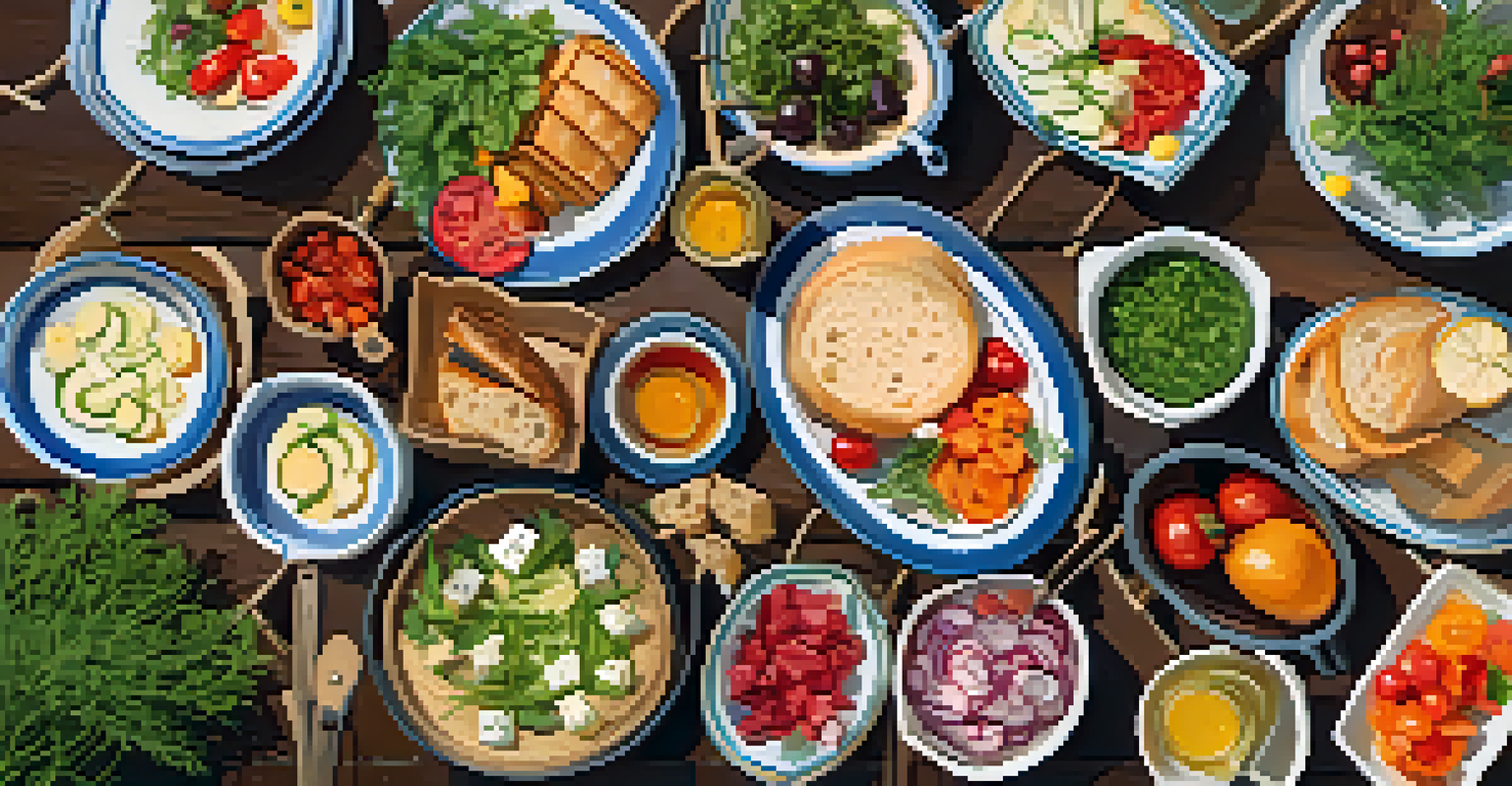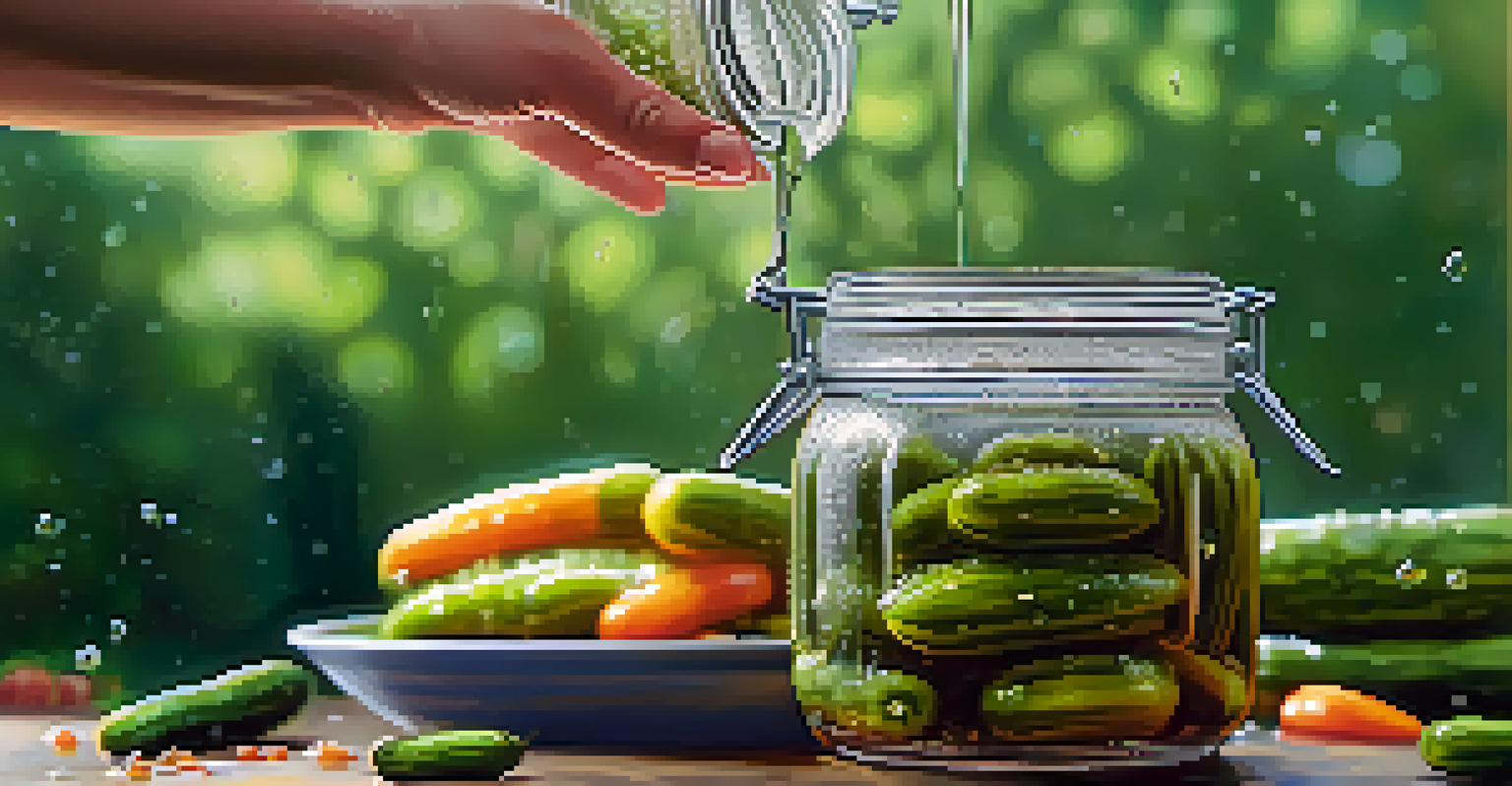Pickling 101: A Beginner's Guide to Flavor and Preservation

What is Pickling and Why Should You Try It?
Pickling is a time-honored method of preserving food by immersing it in a brine or vinegar solution. This process not only extends the shelf life of your favorite veggies and fruits but also adds a delightful tanginess that can elevate any dish. Whether you're a seasoned chef or a kitchen novice, pickling is an accessible way to explore new flavors and textures.
Preserving food is a way of preserving culture.
The beauty of pickling lies in its versatility. You can pickle just about anything—from cucumbers and carrots to even watermelon rinds! Each ingredient brings its own unique taste to the table, allowing you to experiment and find combinations that excite your palate. Plus, pickled foods are often rich in probiotics, which can be beneficial for gut health.
So, if you're looking for a fun and creative way to preserve seasonal produce or simply experiment with bold flavors, pickling is the perfect avenue to explore. It's not just about preservation; it's about enhancement!
Essential Pickling Ingredients You Need
To get started with pickling, you'll need a few key ingredients. The foundation of any pickle is a brine, which typically consists of vinegar, water, and salt. White vinegar is a popular choice due to its sharp flavor, but apple cider vinegar can add a sweeter, more complex taste. Choosing the right vinegar is crucial as it sets the tone for your pickling experience.

Alongside vinegar, you'll want to gather spices and flavorings to enhance your pickles. Common additions include mustard seeds, dill, garlic, and red pepper flakes. These ingredients can transform plain cucumbers into zesty dill pickles or spicy carrots, making each jar a unique culinary creation.
Pickling Preserves and Enhances Flavor
Pickling is a versatile method that not only extends the shelf life of fruits and vegetables but also adds a delightful tanginess to enhance your dishes.
Don't forget about the produce! Fresh vegetables and fruits are the stars of pickling, so select those that are in season for the best flavor and texture. A visit to your local farmer's market can be a great way to find the freshest ingredients and get inspired for your next pickling adventure.
Basic Pickling Methods: Quick vs. Fermented
When it comes to pickling methods, there are two main categories: quick pickling and fermented pickling. Quick pickling, as the name suggests, allows you to enjoy your pickled goods shortly after preparation. This method typically involves heating the brine and pouring it over your vegetables, making it perfect for those who want immediate gratification.
The best way to preserve food is to eat it.
On the other hand, fermented pickling takes a bit longer but offers a deeper, more complex flavor profile. This method relies on natural bacteria to ferment the vegetables over several days or weeks, resulting in tangy, probiotic-rich pickles. Think of it as a culinary journey where patience rewards you with exceptional taste.
Both methods have their charm, and trying out each can help you discover your personal favorite. Whether you opt for the quick route or dive into fermentation, you’re sure to enjoy the process and the delicious results!
Step-by-Step Guide to Quick Pickling
Ready to jump into quick pickling? Start by preparing your vegetables—wash, peel, and slice them as desired. For example, cucumbers can be cut into spears or coins, while carrots can be julienned for a fun presentation. The key is to make sure your vegetables are uniform in size to ensure even pickling.
Next, create your brine by combining vinegar, water, and salt in a pot. Bring the mixture to a boil, allowing the salt to dissolve completely. From here, you can add your spices and flavorings to the brine—feel free to get creative! Once your brine is ready, pour it over the prepared vegetables in a clean jar.
Key Ingredients for Successful Pickling
The essential ingredients for pickling include vinegar, water, salt, and a variety of spices, all of which contribute to the unique flavors of your pickled creations.
Finally, let your pickles cool to room temperature before sealing the jar and placing it in the refrigerator. In just a few hours, you’ll have a delicious, tangy snack ready to enjoy. Quick pickling is not just simple, but it’s also a great way to make the most of seasonal produce!
Fermentation: A Deeper Dive into Flavor
If you're intrigued by fermentation, you're in for a treat! This method involves immersing your vegetables in a saltwater brine and allowing them to sit at room temperature for several days. During this time, beneficial bacteria work their magic, transforming your veggies into deliciously tangy pickles packed with probiotics.
Start by creating a saltwater brine—typically, a 2% salt solution works well. Place your prepared vegetables in a clean jar, pour the brine over them, and ensure they’re fully submerged (a weight can help with this). Cover the jar loosely to allow gases to escape while preventing contaminants from entering.
Check on your pickles daily, tasting them until they reach your desired flavor. The fermentation process can take anywhere from a few days to a couple of weeks, depending on the temperature and your taste preferences. Once they're just right, transfer them to the fridge to slow down fermentation and enjoy your homemade probiotic-rich snacks!
Common Pickling Mistakes to Avoid
Like any culinary adventure, pickling comes with its own set of challenges. One common mistake is not using enough salt in the brine. Salt is essential for flavor and preservation, so be sure to follow recipes closely. Insufficient salt can lead to spoilage, turning your pickling project into a disappointing experience.
Another pitfall is overcooking the brine. Heat can alter the flavor and properties of the vinegar, leading to a less-than-desirable outcome. Aim to bring the brine just to a boil and then remove it from the heat to maintain that crisp, fresh taste in your pickles.
Quick vs. Fermented Pickling Methods
Understanding the difference between quick pickling for immediate enjoyment and fermented pickling for deeper flavors allows you to choose the method that suits your culinary needs.
Lastly, be cautious about the freshness of your ingredients. Wilting vegetables or expired spices can drastically affect the quality of your pickles. Always use the freshest produce and spices to ensure the best flavor and longer shelf life for your pickled creations.
Creative Ways to Use Pickled Foods
Now that you have some delicious pickles, how can you incorporate them into your meals? Pickled vegetables make a fantastic addition to sandwiches, adding crunch and acidity that enhances flavor. Try layering pickles in a classic deli sandwich or on a burger for an extra zing that will tantalize your taste buds.
They also shine in salads! Chopped pickles can add a delightful tang to potato salad or coleslaw, providing a refreshing contrast to creamy textures. You can even blend them into dressings for a unique twist that elevates your salads to gourmet status.

Don't forget about snacking! Pickled veggies can be enjoyed straight from the jar as a zesty snack or paired with cheese and crackers for a simple appetizer. The possibilities are endless, and each bite can remind you of the fun you had crafting those homemade pickles.